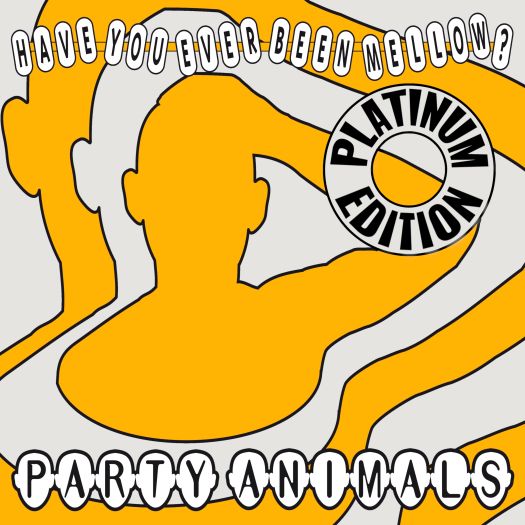The Party Animals have released a new single: "Funny"

Funny was written in the late 90s by Peter-Paul Pigmans, known as 3 Steps Ahead, and now produced again in 2025 by Jeroen Flamman with vocals by Martijn, Rick, Roderick, Dalí and Tim, recorded in Studio Le Roy.
It has long been a regular tune in the car on the way to the performances and with a text that is still completely relevant today, it is time to breathe new life into the song and bring it back into the spotlight.
Unknowingly, the release date of January 31 coincides with the birthday of Peter-Paul Pigmans. He was born on January 31, 1961 and passed away on August 27, 2003.
With Funny, the Party Animals continue their Happy Hardcore tradition with the recognizable sound of Good to Go, Used & Abused and Atomic. There is a full version, the Amnesia Mix and a short version, the Radio Mix.
Have You Ever Been Mellow - Platinum Edition
With over 35 million Spotify streams "Have You Ever Been Mellow" has reached the platinum status. Time to celebrate with a Platinum Edition:


We're happy with it!
De release opens with "Dr. Rude presents: Tempo Team RMX". Blazing hard, while we still can.. "How Low Can You Go?"
Follows "Flamman & Abraxas Bonus Mix 1, 2 & 3": Unique original complete studio recordings from 1995 of "Have You Ever Been Mellow" previously unreleased.
Then the well-known, platinum "Flamman & Abraxas Radio Mix" and last the "Glockenspiel Ringtone": the intro of "Have You Ever Been Mellow" 40 second version as of today your ringtone?
We revamped the music video!
We go Back To The Future to the locations in the Amsterdam Red Light district where in 1995 we filmed the original Have You Ever Been Mellow music video. Read all about it at partyanimals.nl.
The Amsterdam label Lower East Side Records plays a crucial role in the creation of the (international) dance scene as we know it today. The label was created in a period when House music - then a radically new sound from the United States - was often laughed off. Nearly forty years and many revolutions, hypes, ups and downs later, Lower East Side Records still exists. This makes it by far the oldest label for electronic music in the Netherlands.
Lower East Side Records is the platform for all activities of producer duo Jeroen Flamman & Jeff 'Abraxas' Porter. Gripped by the House virus in New York, the two embark on a mission in 1988: to introduce the Netherlands to this new music. Through various private parties, club nights and producing music. Flamman: 'We wanted to play house all night long, but that was almost impossible in the early days. Then we played a good single again a few hours later. That's when the idea arose to start making music myself.' Lower East Side Records is born.
The first releases are from Flamman & Abraxas themselves, under the alias Fierce Ruling Diva. I don't wanna be a freak is an excellent start, Whipped Kream becomes an international underground hit, but the Lower East Side explodes with Rubb It In. With this single, Fierce Ruling Diva has a worldwide club hit, which is still being played today. Flamman: 'It just kept going and came on all kinds of compilation CDs. We once calculated that there are about a million copies of Rubb it in it.' Fierce Ruling Diva immediately becomes an international act. The group is the first Dutch act in the Billboard Dance Chart, which has resulted in several tours in America. As an electronic live act, Fierce Ruling Diva plays in an illustrious row with names such as 808 State, The Prodigy and Moby. Flamman: ‘It also generated comments. Where's your guitar? And you don't have a drum kit!' But much more often there are great successes. Fierce Ruling Diva is the international figurehead of Dutch dance, as is clear when attending the Midem in Cannes and the Winter Music Conference in Miami.
Lower East Side Records gets a creative and financial boost from the success of Fierce Ruling Diva. That attracts many other artists. Flamman & Abraxas produce the first record for the label by Dano (who would become the first Dutch DJ idol in the nineties) and Dylan Hermelijn (who still performs worldwide as 2000 and One): The Sound Of Planet Earth. The record will be recorded at Planet E, the label's own club.
Super talent Orlando Voorn also finds his home at the Lower East Side. As Frequency he scores several hits on the label, including. with Hey, Hey, Hey and Kiss The Sky. It makes Lower East Side the leading label of the early house years. Several international artists have also noticed this. Frank de Wulf, Juan Atkins, Lenny Dee and the very young Richie Hawtin and John Aquaviva also produce for the Lower East Side. ‘Although the latter did so under a different name: Two Guys In The Basement. Their label Plus 8 didn't allow it under their own name,' says Abraxas.
Lower East Side is also leading when it comes to parties. With their rave Warehouse 90, musical rules are broken. A year later, in 1991, HouseNation is the largest dance event to date. After Planet E, the duo also runs Subtopia, an after hours club behind Amsterdam Central Station. Flamman & Abraxas see all activities as pure necessity. Through their own parties and club nights, and through their label with which they operate completely independently, they make a genre that is hardly taken seriously worldwide. It makes the absolute pioneers, the forerunners of a whole new generation.
Every Monday evening Lower East Side organizes i.s.w. DJ Dano and the Mazzo the famous and infamous Manic Monday. The club night started in 1991 and has been the place in Amsterdam to hear new music for years. Moreover, the dance scene itself is free on Monday, making Manic Monday also – as Flamman himself says – a 'weekly company party'. DJs like Darkraver and Lady Dana are often there. Manic Monday means the first booking in the Netherlands for many international artists, for example Jeff Mills, Josh Wink and Richie Hawtin. This makes Flamman & Abraxas an inspiration to many. Or a competitor. Or both, as in the eyes of ID&T, which started Thunderdome in 1992.
Where the Lower East Side always had a stubborn DIY mentality in the early years, this focus shifted around 1993. The Netherlands then started 'hakken' en masse: gabber is the largest youth culture the Netherlands has ever had. Flamman & Abraxas decide to focus on producing music other than for Fierce Ruling Diva. Where Lower East Side first does everything itself, it now collaborates with other labels for business under license. Flamman: 'The Lower East Side, for example, went from two guys who wanted to do everything alone, to an umbrella under which 50 people from all kinds of disciplines worked.' The focus on music resulted in a world hit: I Wanna Be A Hippy, a remix for Technohead. Flamman & Abraxas refine the sound and launch a new act: the Party Animals. The group - consisting of constantly changing members - became the figurehead of happy hardcore. Fast tracks with a hardcore kick, but also with cheerful sing-along elements. The genre only increases the popularity of hardcore and gabber. In this way, Flamman & Abraxas once again play a leading role in a musical revolution.
The Party Animals score one hit after another: Have You Ever Been Mellow, Aquarius and Hava Naquila. The tracks are released by hardcore label Mokum Records in collaboration with Lower East Side. The Party Animals perform throughout the country. For example, Lower East Side Records operated more as a music production and artist management house at that time. That is something the organization maintains throughout its existence: adapting to the times and circumstances.
When hardcore experiences a huge dip in 1999, it also hits the Party Animals and Lower East Side. Flamman: 'Suddenly hardcore was declared dead: now we have Tiësto. That was a downer for us. Fortunately, we have always been able to upsize and downsize the label. And then we started to focus more on oldskool DJ sets' Flamman & Abraxas venture with Double Date (Email to Berlin) on a - not very successful - entry for the Eurovision Song Contest. That seems extreme, but that's not how the producers see it. "We've always done it that way. You're trying to set up something no one expects. Sometimes it works and sometimes it doesn't, but at least it's never middle of the road. We have always said to each other: the sound must be timeless. Very carefully in the mix and always perfect. As a result, many of our releases are still standing," says Flamman, who was called the Dutch Malcolm McLaren by Wessel van Diepen.
A few years after the dip, hardcore gets a whole new appreciation. As a result, the Party Animals are also experiencing a revival. First during student parties, later at all the festivals and events you can think of. In 2018, the Party Animals perform as if the nineties never ended. But Lower East Side doesn't just lean on past successes. In 2007 Patrick Jumpen cleverly jumps into the popular Jump sound. A sound that, in Flamman's opinion, is actually not that far from Fierce Ruling Diva, but which has a different image due to the parochial spirit. Either way, it's another row of hits. In fact, the album 'One Man Army' is one of the best selling albums from Lower Eastside Records.
In 2018, the focus of Lower East Side Records is on the performances of the Party Animals. In 2014 the group released the overview work 'Greatest Hits & Underground Anthems' that was very well received. Furthermore, the Lower East Side is looking ahead again. Brand new releases are planned for 2019 and remixes of one of their biggest hits, Good to Go. An apt title for one of the most influential labels in the global dance industry.
